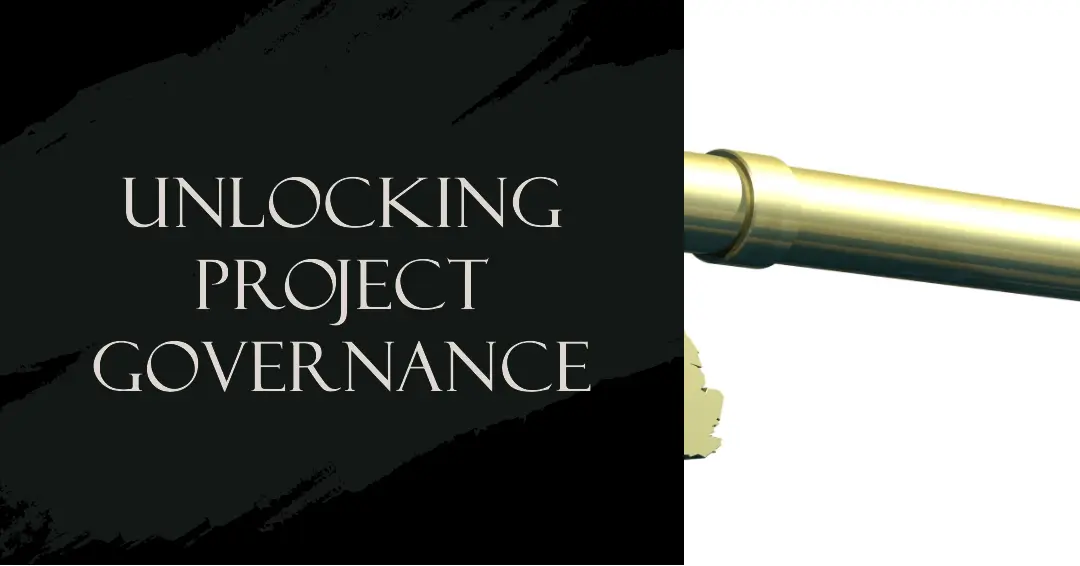To find out how Artificial Intelligence is changing the Project Management landscape, you may enjoy reading this article https://www.shaunstoltz.com/did-artificial-intelligence-just-change-everything-about-project-management/
I Introduction
In the realm of project management, it’s often said that success is in the details. Yet, it’s not just the details of task assignments or deadlines that determine a project’s triumph. It’s also the structures and frameworks we put in place to guide those details towards desired outcomes. One such pivotal framework is project governance.
Project governance is a holistic and integrated approach that guides project decisions and ensures alignment with the organization’s strategic objectives. This systematic process encompasses the organization’s project management philosophy, methodologies, and tools that maintain control over the project’s lifecycle.
Understanding project governance can seem like a complex task, but it doesn’t have to be. In this blog post, we are going to simplify this concept by breaking it down into seven key components. Each of these components plays a critical role in project governance, ensuring that your project stays on track, meets its objectives, and delivers value to all stakeholders.
The seven key components of project governance we will explore are:
- Strategic Alignment
- Risk Management
- Stakeholder Engagement
- Project Lifecycle Management
- Resource Optimization
- Performance Measurement
- Continuous Improvement
By the end of this post, you will have a deeper understanding of these components and how they can be effectively applied to enhance project success. Whether you are a seasoned project manager or just getting started in the field, these insights can help you navigate the intricate world of project governance with ease and confidence. So, let’s dive in and unlock the power of effective project governance together.
II The Role of Project Governance
If project management is the vehicle driving your project towards its goals, consider project governance as the GPS system that ensures you’re heading in the right direction. It’s the framework that defines roles, delineates responsibilities, and establishes procedures to ensure that your project’s strategic goals align with your organization’s vision.
Project governance is not merely a managerial luxury; it’s a necessity. Without it, your project risks becoming a rudderless ship, susceptible to inefficiencies, miscommunication, and failure. On the other hand, effective project governance can lead to increased productivity, improved stakeholder satisfaction, and a higher probability of project success.
Think about the construction of a skyscraper. It’s not enough for architects to design and builders to build. There needs to be a robust structure of oversight to ensure that the design aligns with the project’s goals, that every brick laid is compliant with regulations, and that resources are optimally utilized. This structure of oversight is project governance.
To bring this concept closer to home, consider a real-world example from the tech industry. Google’s development of Gmail is a classic instance of successful project governance. When Gmail was first conceptualized, the project’s strategic alignment with Google’s aim to ‘organize the world’s information and make it universally accessible and useful’ was established. This was followed by meticulous risk management, stakeholder engagement, project lifecycle management, resource optimization, performance measurement, and continuous improvement. The result? Gmail evolved from being a simple email service to an integral part of Google’s G Suite, serving over 1.5 billion users worldwide as of 2021.
This example illustrates the pivotal role of project governance in translating a project’s vision into reality. In the following sections, we will delve deeper into each of the seven key components of project governance, offering practical insights on how to leverage them for project success. Whether your project is a pioneering tech initiative or a local community endeavor, these governance components can provide the structural support needed to turn your vision into a reality.
III First Key Component: Strategic Alignment
Strategic alignment is the cornerstone of effective project governance. It is the process of ensuring that every project initiative aligns with the broader organizational strategy and contributes meaningfully to the achievement of overall business objectives.
Why is strategic alignment so crucial for project governance? Simply put, a project that doesn’t align with the organization’s strategy is like a ship sailing without a compass—it might be moving, but it’s not necessarily going in the right direction. Strategic alignment ensures that every project contributes to the company’s broader goals, maximizing the return on investment and avoiding wasted effort on initiatives that don’t support the organization’s vision.
Achieving strategic alignment involves a clear understanding of your organization’s strategic goals and then mapping these goals onto your project initiatives. It requires ongoing communication and collaboration between project teams and organizational leadership.
Here are some practical tips on how to ensure strategic alignment in your projects:
Understand the Organizational Strategy: Before embarking on any project, ensure you have a clear understanding of the organization’s strategy. This understanding will serve as a guiding light throughout the project lifecycle.
Define Clear Project Objectives: Set clear and measurable project objectives that align with the organizational strategy. These objectives should guide all project decisions and actions.
Ensure Consistent Communication: Regularly communicate with stakeholders to ensure the project remains aligned with strategic objectives. This communication should be transparent, two-way, and continuous.
Monitor and Adjust: Monitor project progress regularly and be ready to make adjustments as necessary to maintain alignment with the strategic goals.
In essence, strategic alignment is not a one-time task, but a continuous process that requires active monitoring and management. By keeping your projects strategically aligned, you not only enhance project success but also contribute more effectively to your organization’s overarching goals.
IV Second Key Component: Risk Management
In the world of project management, the only certainty is uncertainty. Every project, regardless of size or complexity, carries with it a degree of risk. This is where the second key component of project governance, risk management, comes into play.
Risk management is the systematic process of identifying, analyzing, and mitigating the potential risks that could threaten a project’s success. It’s like the insurance policy of project governance, offering a safety net that can prevent minor issues from escalating into major problems.
The importance of risk management in project governance cannot be overstated. Without it, projects become susceptible to unexpected issues that can derail progress, inflate costs, and compromise deliverables. Effective risk management, on the other hand, can improve project predictability, enhance stakeholder confidence, and increase the likelihood of achieving project objectives.
Here are some practical strategies for effective risk management in your projects:
Identify Potential Risks: The first step in risk management is identification. This involves brainstorming potential risks that could impact your project, from resource shortages to technical challenges. The more comprehensive your risk identification process, the better prepared you’ll be to manage these risks.
Analyze and Prioritize Risks: Not all risks are created equal. Some pose a greater threat to your project than others. Analyze each identified risk based on its potential impact and likelihood of occurrence. This will help you prioritize your risk management efforts.
Develop Risk Response Plans: For each high-priority risk, develop a response plan. This might involve mitigating the risk, transferring it, accepting it, or avoiding it altogether. Your risk response plan should detail the actions to be taken if the risk materializes.
Monitor and Review Risks: Risk management is an ongoing process that doesn’t end once you’ve developed your risk response plans. Regularly review and update your risk register to reflect new risks and changes to existing ones.
Remember, risk management isn’t about eliminating all risks—that’s an impossible task. Instead, it’s about being prepared for risks and having a plan in place to manage them effectively. By integrating risk management into your project governance framework, you can navigate the uncertain waters of project management with confidence and poise.
V Third Key Component: Stakeholder Engagement
No project operates in a vacuum. Each one involves a diverse range of stakeholders, from project team members and managers to clients, end-users, and even the public. This brings us to the third key component of project governance: stakeholder engagement.
Stakeholder engagement is the process of identifying, communicating with, and managing relationships with all individuals or groups who have a stake in the project’s outcome. It’s like the diplomacy of project governance, fostering mutual understanding and collaboration among all parties involved.
The importance of stakeholder engagement in project governance cannot be understated. When stakeholders feel engaged and heard, they are more likely to support the project, contribute valuable insights, and help mitigate potential issues. On the other hand, poor stakeholder engagement can lead to misunderstandings, resistance, and even project failure.
Here are some tips for improving stakeholder engagement in your projects:
Identify Your Stakeholders: Begin by identifying who your stakeholders are. Remember, a stakeholder isn’t just someone who is directly involved in the project. It’s anyone who can affect or be affected by the project’s outcome.
Understand Stakeholder Interests and Expectations: Once you’ve identified your stakeholders, take the time to understand their interests, expectations, and concerns. This will help you tailor your communication and engagement efforts to meet their unique needs.
Develop a Communication Plan: Effective stakeholder engagement hinges on clear and consistent communication. Develop a communication plan that outlines what information will be communicated, when, how, and to whom.
Involve Stakeholders in Decision-Making: Whenever possible, involve stakeholders in project decision-making. This not only ensures their perspectives are considered but also promotes a sense of ownership and commitment to the project.
Seek and Respond to Feedback: Regularly seek feedback from stakeholders and respond promptly and constructively. This shows that you value their input and are committed to meeting their needs.
In essence, stakeholder engagement is all about building and maintaining positive relationships with those who have a stake in your project. By prioritizing this critical component of project governance, you can foster a collaborative environment that drives project success and delivers value to all stakeholders.
VI Fourth Key Component: Project Lifecycle Management
Every project, like a living entity, goes through various stages during its life. These stages, from initiation to closure, collectively form the project lifecycle. Our fourth key component of project governance, project lifecycle management, involves overseeing and controlling these stages to ensure the project’s successful completion.
Project lifecycle management is the beating heart of project governance. It provides a structured approach to project execution, enabling managers to break down complex projects into manageable phases, each with its specific tasks, objectives, and deliverables.
Effective project lifecycle management can streamline project execution, enhance efficiency, and improve the quality of deliverables. It provides a roadmap that guides the project team from start to finish, ensuring that all project activities align with the project’s objectives and the organization’s strategic goals.
Here are some practical steps for managing the project lifecycle effectively:
Understand the Project Lifecycle: Familiarize yourself with the typical stages of a project lifecycle: initiation, planning, execution, monitoring and control, and closure. Understanding these stages can help you manage each phase effectively.
Develop a Project Plan: The project plan is the blueprint of your project. It outlines the project’s scope, objectives, deliverables, timeline, and resources. It also defines the roles and responsibilities of the project team, thereby setting the stage for successful project execution.
Monitor Project Progress: Keep a close eye on the project’s progress throughout its lifecycle. Regularly compare actual performance with planned performance to identify any deviations and take corrective action as necessary.
Communicate Regularly: Keep all stakeholders informed about the project’s progress, challenges, and successes. Regular communication can help manage expectations, foster stakeholder engagement, and promote transparency.
Close the Project Formally: Once the project deliverables have been produced and accepted, close the project formally. This involves releasing project resources, documenting lessons learned, and celebrating the project’s success.
In essence, project lifecycle management is a disciplined approach to project execution. It helps project managers navigate the complexities of their projects, ensuring that each phase is effectively managed and controlled. By integrating project lifecycle management into your project governance framework, you can enhance project success and deliver greater value to your stakeholders.
VII Fifth Key Component: Resource Optimization
Resources—be it time, money, or human capital—are the lifeblood of any project. However, they are often limited and need to be judiciously allocated and managed. This brings us to our fifth key component of project governance: resource optimization.
Resource optimization is the process of using the available resources in the most efficient and effective manner possible to achieve project goals. It’s like the stewardship of project governance, ensuring that every resource is maximized to its fullest potential.
The importance of resource optimization in project governance is immense. It can lead to cost savings, improved efficiency, and increased project success. Conversely, poor resource management can result in wasted resources, project delays, and even failure.
Here are some strategies for optimal resource optimization in your projects:
Identify and Prioritize Resources: Understand what resources are available to you and prioritize them based on their importance to the project. This will help you make informed decisions about resource allocation.
Create a Resource Allocation Plan: Develop a plan that outlines how and when resources will be used throughout the project. This plan should be flexible enough to accommodate changes in the project’s scope or timeline.
Monitor Resource Usage: Regularly track how resources are being used and compare this with your resource allocation plan. If resources are being underused or overused, make adjustments as necessary.
Leverage Technology: Use project management software to assist in resource management. These tools can provide a visual representation of resource allocation, making it easier to identify bottlenecks or areas of inefficiency.
Promote a Culture of Efficiency: Encourage all team members to use resources wisely. This could involve training on efficient work practices or recognizing team members who demonstrate effective resource management.
In essence, resource optimization is all about doing more with less. It involves making smart decisions about how to allocate and manage resources to achieve the best possible project outcomes. By prioritizing resource optimization in your project governance framework, you can drive efficiency, save costs, and enhance the overall success of your projects.
VIII Sixth Key Component: Performance Measurement
“Without data, you’re just another person with an opinion,” W. Edwards Deming, a renowned statistician, and management consultant once said. This quote underscores the importance of our sixth key component of project governance: performance measurement.
Performance measurement involves tracking and analyzing key project metrics to assess the project’s progress and effectiveness. It’s like the dashboard of project governance, providing valuable insights into the project’s health and informing decision-making.
Effective performance measurement is crucial for successful project governance. It allows project managers to identify issues early on, make data-driven decisions, and demonstrate the project’s value to stakeholders. Without it, project managers are essentially flying blind, relying on intuition rather than facts to guide their actions.
Here’s how you can implement effective performance measurement in your projects:
Identify Key Performance Indicators (KPIs): KPIs are metrics that measure the critical aspects of project performance. These could include cost variance, schedule variance, scope creep, and stakeholder satisfaction, among others. Choose KPIs that align with your project’s objectives and stakeholder expectations.
Establish a Baseline: Before you can measure performance, you need to establish a baseline. This is a reference point against which actual performance is compared. Your baseline should be established during the planning phase of the project and should reflect the project’s scope, schedule, and budget.
Track and Analyze Performance Data: Regularly collect and analyze performance data. Use project management software to automate data collection and generate real-time performance reports.
Communicate Performance Information: Share performance information with all stakeholders. This not only keeps them informed about the project’s progress but also promotes transparency and accountability.
Use Performance Data to Inform Decision-Making: Use the insights gleaned from performance measurement to inform project decision-making. If performance metrics indicate that the project is off track, take corrective action to get it back on course.
In essence, performance measurement provides the data needed to manage projects effectively. By integrating performance measurement into your project governance framework, you can drive project success, enhance stakeholder satisfaction, and elevate your project management practice to a new level of excellence.
IX Seventh Key Component: Continuous Improvement
In the ever-evolving world of project management, standing still is not an option. To stay competitive and maximize project success, organizations must be committed to continuous improvement. This is our seventh and final key component of project governance.
Continuous improvement involves regularly reviewing and refining project processes to enhance efficiency, effectiveness, and value. It’s like the evolution of project governance, ensuring that your project practices keep pace with changing business environments and stakeholder expectations.
Continuous improvement is crucial for effective project governance. It fosters innovation, drives efficiency, and enhances project outcomes. Without it, organizations risk becoming complacent, missing out on opportunities for improvement, and falling behind their competitors.
Here are some strategies for embedding continuous improvement in your project governance framework:
Conduct Post-Project Reviews: Once a project is completed, conduct a post-project review to identify what went well and what could be improved. This should involve all project stakeholders and cover all aspects of the project, from planning and execution to communication and deliverables.
Capture and Share Lessons Learned: Document the lessons learned from each project and share them with the entire organization. This not only helps avoid repeating the same mistakes but also facilitates the sharing of best practices.
Invest in Training and Development: Regularly upskill your project team to keep them abreast of the latest project management methodologies, tools, and techniques. This could involve formal training programs, workshops, or mentoring.
Solicit and Act on Feedback: Regularly solicit feedback from project stakeholders and act on it. This shows that you value their input and are committed to meeting their needs.
Foster a Culture of Improvement: Encourage all team members to look for ways to improve project processes and outcomes. Recognize and reward those who contribute to improvement efforts.
In essence, continuous improvement is all about learning, growing, and evolving. It involves taking a proactive approach to project improvement, turning every project into an opportunity for learning and growth. By making continuous improvement a core component of your project governance framework, you can drive project success and create a culture of excellence that permeates every level of your organization.
With these seven key components—strategic alignment, risk management, stakeholder engagement, project lifecycle management, resource optimization, performance measurement, and continuous improvement—you can unlock the full potential of project governance. When applied effectively, these components can enhance project success, deliver value to all stakeholders, and drive your organization towards its strategic goals.
X In Conclusion
Project governance is more than a concept—it’s a potent tool that, when wielded correctly, can significantly enhance the success rate of your projects. It provides a holistic framework, weaving together diverse aspects like strategic alignment, risk management, stakeholder engagement, project lifecycle management, resource optimization, performance measurement, and continuous improvement.
As we’ve seen in this blog post, each of these seven key components plays a vital role in creating a robust and effective project governance framework. Together, they provide the compass that guides your projects toward their intended objectives, while ensuring alignment with organizational goals, optimal resource usage, and maximum value delivery.
Strategic alignment ensures that every project is in sync with the organization’s objectives and strategic direction. Risk management provides a safety net, helping you anticipate and mitigate project risks. Stakeholder engagement fosters a collaborative environment, ensuring that all voices are heard and considered.
Project lifecycle management breaks down the complexity of projects into manageable stages, ensuring a smooth journey from inception to completion. Resource optimization ensures that every resource is leveraged to its full potential, driving efficiency and cost-effectiveness.
Performance measurement provides the data you need to make informed decisions and demonstrate the project’s value. Lastly, continuous improvement ensures that your project practices evolve with changing business environments and stakeholder expectations.
As we wrap up this exploration into the world of project governance, remember that these components aren’t just boxes to check—they’re critical success factors that require ongoing attention and refinement. Implementing them will require patience, commitment, and a willingness to learn and adapt. But the rewards—improved project success, enhanced stakeholder satisfaction, and a reputation for excellence—make it a worthwhile journey.
So, as you embark on your next project, consider how you can unlock these seven key components of project governance. Remember, in the world of project management, success isn’t an accident—it’s the result of careful planning, disciplined execution, and a robust governance framework.
Find out more about Shaun Stoltz https://www.shaunstoltz.com/about/
This post was written by an AI and reviewed/edited by a human.



